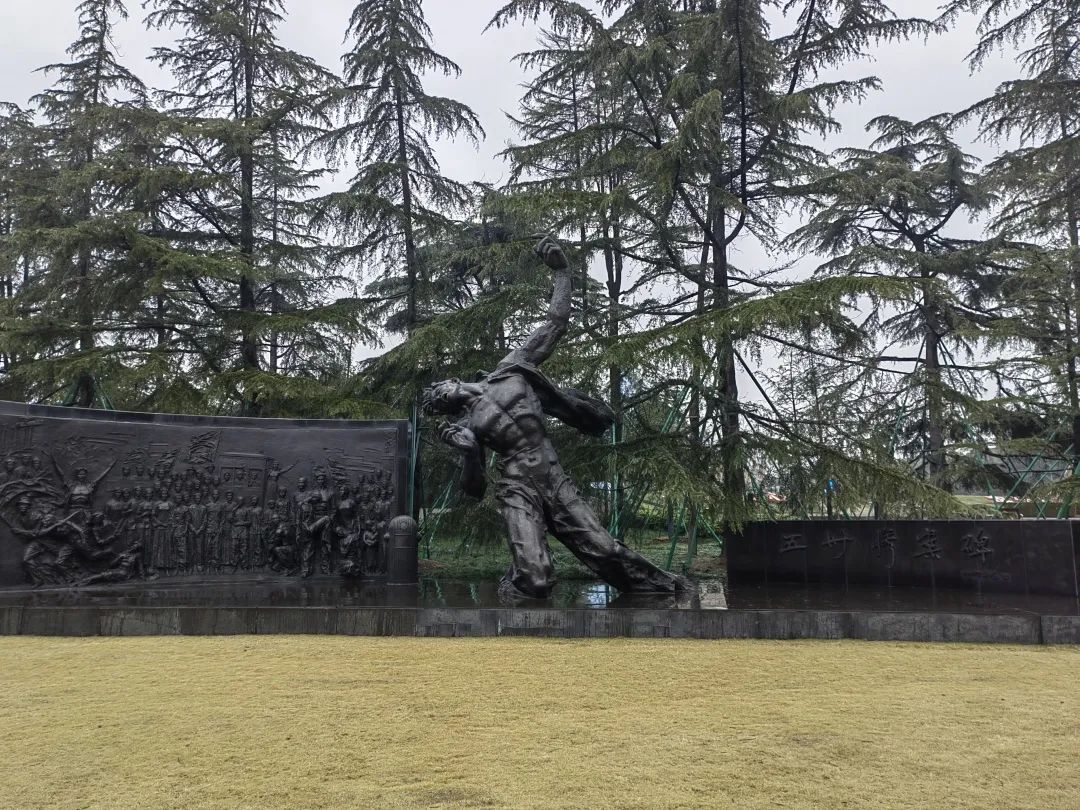编者按:2021年,为实现党建联动区域化、促进党史教育机制化,上海外国语大学与上海龙华烈士陵园举办签约共建仪式,开展建党百年、百+共建专题活动,引导广大青年在学思践悟中传颂先辈故事、坚定理想信念。上外英院龙陵青年志愿服务队从译介角度进行实践。继人物篇和文物篇后,“龙陵x英华青年说”现推出第三季故事篇,继续讲演中国共产党人的革命故事,积极推广文化译介新理念,助力红色文化“走出去”。

图为群雕《五卅惨案》
(摄于上海龙华烈士纪念馆)
朗诵者:2021级本科生陈若希
悲壮雄伟的历史交响诗——五卅惨案的群雕
A Solemn and Stirring Symphony: Stories Behind the Sculptures of the May 30th Tragedy
龙华烈士陵园主题雕塑西侧环路边草坪,芳草萋萋,青松苍翠,雕塑家王克庆创作的《五卅惨案》雕塑坐落其间。这组雕塑面朝西南,依松为屏,造型生动,气势雄浑,雕塑及其环境形成了陵园中又一处令人难忘的景点。
Against the lush grass and verdant pines, the sculptures of the May 30th Tragedy, created by sculptor Wang Keqing, stands on the lawn along the western side of the Longhua Martyrs’ Mausoleum. Facing the southwest and surrounded by pines, this group of sculptures is vivid and majestic, which forms an unforgettable attraction in the mausoleum, along with its environment.
《五卅惨案》雕塑作者王克庆是北京中央美术学院雕塑创作研究室教授、时任全国城市雕塑建筑指导委员会代主任。王克庆是我国著名的雕塑家,早年由中央美院委派送往苏联彼得格勒列宾美术学院深造,面受苏联大雕塑家米·康·阿尼库申的亲自指导,留苏期间并与苏联一些世界级的雕塑大师交流。回国后数十年来,他创作了《白求恩在太行山》、《农奴愤》(集体创作)、《李大钊》、《朱自清像》、《闻一多纪念像》(合作)、我国送日本长崎的《和平少女》(合作)等优秀雕塑作品,取得了巨大的艺术成就。
Wang Keqing, the author of the sculptures, is a professor at the Sculpture Creation Laboratory of the Central Academy of Fine Arts in Beijing and the acting director of the National Urban Sculpture and Architecture Steering Committee. As a famous sculptor in China, he in his early years was sent by the Central Academy of Fine Arts for further studies at the Repin Academy in Petergrad (Saint Petersburg after the dissolution of the Soviet Union). There he was guided by the great Soviet sculptor Mikhail Anikushin, and managed to exchange ideas with world-class masters.
For decades since his return to China, he made great artistic achievements. His sculpture works include “Bethune in Taihang Mountain”, “Raging Serf” (co-creator), “Li Dazhao”, “Zhu Ziqing’s Portrait”, “Wen Yiduo Memorial Portrait” (co-creator) and “Girl of Peace” (co-creator). The last one was sent to Nagasaki, Japan, as a token of the two countries’ friendship.
1994年10月,王克庆在龙陵室外雕塑评审会上展示了他设计的《五卅惨案》雕塑的两套不同的方案。方案一,是三角形构图的群像雕塑造型;方案二,是通过单个人物造型,采取写实但不完全自然主义的表现手法表达主题,反映时代背景。11月的评审会上,与会专家一致同意第二方案。但是,王克庆对此方案“总不满意”,之后,他又对该方案反复修改了四稿,历时3年多时间。其中以1995年秋的那次修改为最大。是年8月中旬,市委书记办公会议对龙陵纪念雕塑进行了审定。会议对《五卅惨案》雕塑基本是肯定的,但要求方案进一步完善,在人物及其背景上加强五卅历史事件中的反抗、愤怒的情节与气氛,并体现上海与全国在此运动中的联系。9月,王克庆对方案进行了补充与完善,不仅加强了主雕人物的造型力度,并在主雕人物背后增添了衬托主雕、反映席卷中华大地的五卅反帝风暴历史的大型人物群像浮雕。同时,根据筹建办的建议,浮雕旁增设以原公共租界消火栓为原型的小圆雕。
In October 1994, Wang submitted two designs for the May 30th Tragedy sculpture, which was to be exhibited at the open air space of the Longhua Martyrs Cemetery. The first design consisted of a group sculpture with triangular composition. The second one depicts only one single character, which was to express the theme and reflect the times in a realistic but not completely naturalistic way. At the review meeting in November, the experts unanimously chose the latter. However, Wang was still “not content” with the design and revised it four times. The revision process, which included a substantial change in the fall of 1995, lasted altogether three years.
In the middle of August of the same year, the project of Longhua Martyrs’ Cemetery Memorial Sculpture was approved at the office meeting of the Secretary of the CPC Municipal Committee. The committee, which largely agreed with Wang’s proposed design, suggested changes in character-building and background to strengthen the plot and the atmosphere of resistance and anger, which was raging at the time in support of the Movement, and a reinforced connection between Shanghai and the whole country. In September, Wang improved the design. He not only enhanced the forcefulness of the main figures, but also added a large group relief sculptures to complement them and reflect the history of the May 30th Anti-Imperialist storm that was sweeping the land of China. Moreover, Wang also adopted the preparatory office’s suggestion to add a small round sculpture based on the fire hydrant in the public concession beside the relief.
1998年5月,王克庆写了《<五卅惨案>雕塑创作谈》一文,详述了作为一个人民雕塑家的他对创作这组雕塑的思想与情感以及对作品的诠释。王克庆少年时代在上海度过,接触过水深火热中的劳苦大众,亲眼目睹了帝国主义蹂躏中国人民的悲惨历史。“历史的血与泪”与艺术的灵感激发起他这次创作的激情和艺术构思。他在作品中“采用了写实主义与表现主义融合的艺术手法”,让作品成为“构思开阔、浑厚、凝重、充满动感的雕塑群体,象征着火山爆发的宏伟气势!”作品中主体雕塑烈士人物高大、强壮,牺牲瞬间不屈的精神在上升,死亡与反抗融于一身,突出了顽强的生命力和强烈的抗争,强调了五卅烈士的“反帝勇猛气势和革命精神永存人间”。浮雕再现的65个不同年龄、性别、身份的五卅历史中的中国民众人物,栩栩如生,活灵活现,“追求奔放、潇洒、含蓄、深沉、悲壮、高昂,体现中华民族的悲愤与怒吼!”浮雕背景中塑造的圆明园残迹和上海外滩的租界建筑与雕塑,则衬托了雕塑的“历史内涵的深度与厚度”,以“汇集成悲壮雄伟的历史交响诗”。在这组雕塑的创作中,王克庆倾注了满腔热血与创作激情。他说,该浮雕在上海铸造时,上海的一位观众发现了他自己由于陶醉塑造形象而没有发现的事情——浮雕的人物群像中,他竟采用了许多方法刻画不同人物的眼神!还有位青年看到这浮雕时惊叹道:“这是历史的哭墙!”王克庆说:“我是用全部情感和艺术技巧塑造一个个历史人物,65个人物中却只有一小女孩在哭泣,其他64个人物中却都没有哭……”。“苦难的人民,眼里没有泪,心中在流血。”这也许正是王克庆的雕塑艺术,也是《五卅惨案》雕塑的深刻内涵!
In May 1998, Wang wrote an essay entitled “On the Creation of the Sculptures of the May 30th Tragedy”, detailing his thoughts and feelings about the creation of this group of sculptures and his interpretation of it as a people’s sculptor. According to Wang, he spent his teenage years in Shanghai, where he came into contact with the toiling masses and witnessed the tragic history of imperialism ravaging the Chinese people. The “blood and tears of history” and artistic inspiration lit up his passion and laid the foundation for this work.
In his work, Wang “adopted a fusion of realism and expressionism”, making the work “an ground-breaking, rich, heavy and dynamic sculptural group, symbolizing the grandeur of a volcanic eruption!” The main sculpture of the martyrs is tall and strong, with the spirit of sacrifice rising in the moment of indomitable sacrifice, death and defiance all in one, highlighting the tenacity of life and strong resistance, emphasizing that the May 30th martyrs’ “anti-imperialist courage and revolutionary spirit shall live on forever”. The relief depicts 65 Chinese people of different ages, genders, and identities, all vivid and life-like. Despite the difference of the images of the individuals—“passionate, unrestrained, reserved, solemn mournful or high-spirited”—they all “embody the grief and anger of the Chinese nation!” The ruins of the Yuanmingyuan and the architecture of the Bund are shown in the background of the relief to add to the “historical depth and thickness” of the sculptures, which “together form a solemn and stirring symphony”.
Wang poured his passion and enthusiasm into creating the sculptures. When the relief was cast in Shanghai, an on-looker marveled at how differently he portrayed each figures’ eyes, which was something he himself had not noticed because he was so enthralled by his work. Another young man who saw the relief exclaimed, “This is our crying wall, about our history!” Wang said, “I used all my emotions and artistic skills to shape each historical figure; yet out of the 65 figures I depicted only one, a little girl, is crying, while none of the other 64 figures are shedding tears...” “The suffering people, though without tears in their eyes, are bleeding in their hearts.” This is the exact statement of Wang’s artistry and of the profound connotation of the sculptures of the May 30th Tragedy!
我要评论 (网友评论仅供其表达个人看法,并不表明本站同意其观点或证实其描述)
全部评论 ( 条)